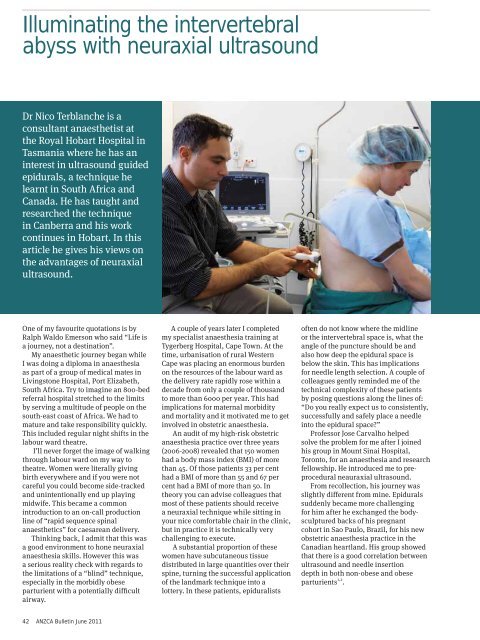ANZCA Bulletin June 2011 - Australian and New Zealand College of ...
ANZCA Bulletin June 2011 - Australian and New Zealand College of ...
ANZCA Bulletin June 2011 - Australian and New Zealand College of ...
You also want an ePaper? Increase the reach of your titles
YUMPU automatically turns print PDFs into web optimized ePapers that Google loves.
Illuminating the intervertebral<br />
abyss with neuraxial ultrasound<br />
Dr Nico Terblanche is a<br />
consultant anaesthetist at<br />
the Royal Hobart Hospital in<br />
Tasmania where he has an<br />
interest in ultrasound guided<br />
epidurals, a technique he<br />
learnt in South Africa <strong>and</strong><br />
Canada. He has taught <strong>and</strong><br />
researched the technique<br />
in Canberra <strong>and</strong> his work<br />
continues in Hobart. In this<br />
article he gives his views on<br />
the advantages <strong>of</strong> neuraxial<br />
ultrasound.<br />
One <strong>of</strong> my favourite quotations is by<br />
Ralph Waldo Emerson who said “Life is<br />
a journey, not a destination”.<br />
My anaesthetic journey began while<br />
I was doing a diploma in anaesthesia<br />
as part <strong>of</strong> a group <strong>of</strong> medical mates in<br />
Livingstone Hospital, Port Elizabeth,<br />
South Africa. Try to imagine an 800-bed<br />
referral hospital stretched to the limits<br />
by serving a multitude <strong>of</strong> people on the<br />
south-east coast <strong>of</strong> Africa. We had to<br />
mature <strong>and</strong> take responsibility quickly.<br />
This included regular night shifts in the<br />
labour ward theatre.<br />
I’ll never forget the image <strong>of</strong> walking<br />
through labour ward on my way to<br />
theatre. Women were literally giving<br />
birth everywhere <strong>and</strong> if you were not<br />
careful you could become side-tracked<br />
<strong>and</strong> unintentionally end up playing<br />
midwife. This became a common<br />
introduction to an on-call production<br />
line <strong>of</strong> “rapid sequence spinal<br />
anaesthetics” for caesarean delivery.<br />
Thinking back, I admit that this was<br />
a good environment to hone neuraxial<br />
anaesthesia skills. However this was<br />
a serious reality check with regards to<br />
the limitations <strong>of</strong> a “blind” technique,<br />
especially in the morbidly obese<br />
parturient with a potentially difficult<br />
airway.<br />
A couple <strong>of</strong> years later I completed<br />
my specialist anaesthesia training at<br />
Tygerberg Hospital, Cape Town. At the<br />
time, urbanisation <strong>of</strong> rural Western<br />
Cape was placing an enormous burden<br />
on the resources <strong>of</strong> the labour ward as<br />
the delivery rate rapidly rose within a<br />
decade from only a couple <strong>of</strong> thous<strong>and</strong><br />
to more than 6000 per year. This had<br />
implications for maternal morbidity<br />
<strong>and</strong> mortality <strong>and</strong> it motivated me to get<br />
involved in obstetric anaesthesia.<br />
An audit <strong>of</strong> my high-risk obstetric<br />
anaesthesia practice over three years<br />
(2006-2008) revealed that 150 women<br />
had a body mass index (BMI) <strong>of</strong> more<br />
than 45. Of those patients 33 per cent<br />
had a BMI <strong>of</strong> more than 55 <strong>and</strong> 67 per<br />
cent had a BMI <strong>of</strong> more than 50. In<br />
theory you can advise colleagues that<br />
most <strong>of</strong> these patients should receive<br />
a neuraxial technique while sitting in<br />
your nice comfortable chair in the clinic,<br />
but in practice it is technically very<br />
challenging to execute.<br />
A substantial proportion <strong>of</strong> these<br />
women have subcutaneous tissue<br />
distributed in large quantities over their<br />
spine, turning the successful application<br />
<strong>of</strong> the l<strong>and</strong>mark technique into a<br />
lottery. In these patients, epiduralists<br />
<strong>of</strong>ten do not know where the midline<br />
or the intervertebral space is, what the<br />
angle <strong>of</strong> the puncture should be <strong>and</strong><br />
also how deep the epidural space is<br />
below the skin. This has implications<br />
for needle length selection. A couple <strong>of</strong><br />
colleagues gently reminded me <strong>of</strong> the<br />
technical complexity <strong>of</strong> these patients<br />
by posing questions along the lines <strong>of</strong>:<br />
“Do you really expect us to consistently,<br />
successfully <strong>and</strong> safely place a needle<br />
into the epidural space”<br />
Pr<strong>of</strong>essor Jose Carvalho helped<br />
solve the problem for me after I joined<br />
his group in Mount Sinai Hospital,<br />
Toronto, for an anaesthesia <strong>and</strong> research<br />
fellowship. He introduced me to preprocedural<br />
neauraxial ultrasound.<br />
From recollection, his journey was<br />
slightly different from mine. Epidurals<br />
suddenly became more challenging<br />
for him after he exchanged the bodysculptured<br />
backs <strong>of</strong> his pregnant<br />
cohort in Sao Paulo, Brazil, for his new<br />
obstetric anaesthesia practice in the<br />
Canadian heartl<strong>and</strong>. His group showed<br />
that there is a good correlation between<br />
ultrasound <strong>and</strong> needle insertion<br />
depth in both non-obese <strong>and</strong> obese<br />
parturients 1,2 .<br />
42<br />
<strong>ANZCA</strong> <strong>Bulletin</strong> <strong>June</strong> <strong>2011</strong>

















